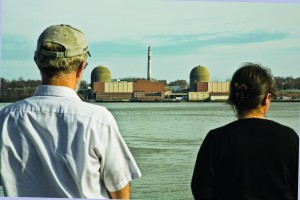Hudson Valley pols stake out positions on plant

Indian Point is a football these days and the Fukushima reactors have signaled kickoff. Some are in favor. Some are opposed. And not a few have laryngitis on the topic. The crowd is edgy, with the news from Japan keeping interest reactor-core hot.
If the “danger zone” is truly greater than the 10-mile radius Entergy currently claims, how do counties like Ulster, Dutchess, Orange and Putnam feel about the continued operations at Buchanan?
When asked about his reaction to the relicensing ”“ or the closing ”“ of the facility, Mike Hein, Ulster County”™s executive, said, “We”™re good on this,” and did not elaborate. Dutchess County Executive William Steinhaus was unavailable for comment. Requests for comments from Paul Eldridge, county executive of Putnam and Orange County Executive Edward Diana went unanswered.
It has not been unusual for counties to ration out PI (potassium iodide) pills on occasion to residents within what Entergy, the plant”™s owner, considers the “10 mile danger zone” surrounding the Buchanan facility. The tragedy in Japan has already witnessed residents evacuated within a 19 mile radius of the facility. (Radiation at press time had also contaminated the tap water of Tokyo and in sea water, causing concern for Japan”™s fishing industry.)
Can a similar catastrophe happen on the Hudson? Entergy says Indian Point is built to withstand an earthquake of 6.0 magnitude ”“ more than twice what has ever been recorded in the area, although the reactors are situated near two fault lines. Security had saturated the area around the plant even before the 9/11 attacks. Now, it”™s a fortress guarded by land, sea and air.
Jim Steets, spokesperson for Entergy told the media at a press conference, “This facility is backed up by diesel generators, which are also backed up … even if we lost electric power, we would still have the power to cool reactors. Indian Point is well-positioned and prepared for a catastrophic occurrence.”
Entergy has many fans, and many detractors, particularly environmental groups such as Riverkeeper, which is challenging Indian Point”™s licensing renewal for its three reactors in 2013 and 2015. Gov. Andrew Cuomo wants it closed.
Rockland County Executive C. Scott Vanderhoef, whose county has an unobstructed view of the plant situated on the Hudson, wants to see Indian Point shut down. “It shouldn”™t be there,” Vanderhoef told members of the RBA at his state of the county address on March 18. “It”™s too densely a populated area. Westchester County does not agree, but I think there is a danger. I don”™t think we can expect to see the same kind of catastrophe Japan suffered, but I”™d still like to see it closed down.”
The plant generates 25 percent of New York City”™s electricity, fills the town of Buchanan”™s coffers with $1.9 million annually, provides nearly 1,700 jobs, and: “should be kept up and running,” said  Deborah Milone, executive director  of the Hudson Valley Gateway Chamber of Commerce in Peekskill. She said Indian Point is diligently monitored for any potential public risk and has the fail safe mechanisms in place to prevent a disaster.
But Cuomo, U.S. Reps. Nita Lowey and Eliot Engel, both Democrats, called for the plant to be shut down. Newly elected Rep. Nan Hayworth, R-Bedford, doesn”™t see the possibility of moving 15 million people out of “harm”™s way” if the plant should call for a 50-mile radius evacuation.
“I live right near it,” Hayworth said in a published interview, “and I can”™t see how we can honestly evacuate 15 million people successfully.” But, she said, “I think Indian Point is well-maintained and more than ready to take on any type of disaster.”
Both U.S. Sens. Charles Schumer and Kirsten Gillibrand have spoken in favor of keeping the plant operating, but have asked that steps be taken to protect the public from a disaster such as the one incurred in Japan.
John Durso Jr., executive director for the New York Affordable Reliable Electricity Alliance, said in a prepared statement: “The nature of energy production is that there are not any “no risk” options. Safety must always be paramount and we must recognize that nuclear energy, by ensuring a stable electricity grid and reducing toxic emissions,